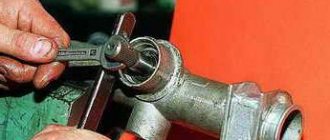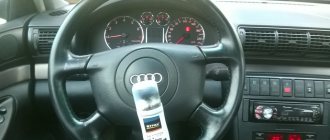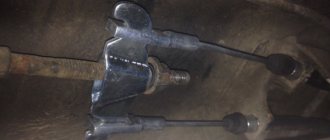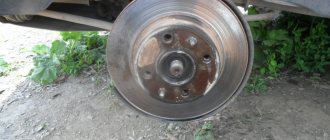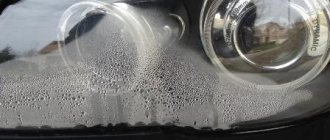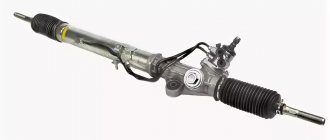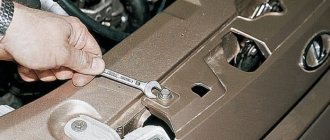I received my license back in the Soviet Union. I remember from the very beginning I used the services of garage specialists and hunted in automobile markets for the necessary spare parts for my Zhiguli.
With increasing driving experience, I learned to carry out simple repairs myself, change individual parts, technical fluids, monitor the condition of the battery - that is, recognize problems at the earliest stages, which is what I want to share.
Today, there are many specialized points that are ready to take on serious work, but they often profit from inexperienced drivers by passing off micro-problems as serious malfunctions.
The main thing is to clearly know when you can do it on your own, and when you should contact a service station and not take risks.
Car maintenance: how it is performed and features of maintenance
In the case of a car, maintenance is a whole range of planned activities, which include diagnostics, testing, adjustment and maintenance, which are prescribed by the car manufacturer.
The main task of maintenance (TO) is to prevent possible problems that may occur at certain mileages. Next, we will look at what types of car maintenance there are, as well as when and why it is necessary to perform car maintenance.
Study the instruction manual.
Before starting any work on your car, read the owner's manual that usually comes with each car. If you haven’t found this in Russian, then try to find it on the Internet.
While many aspects of regular maintenance are universal, there are some that may be specific to a particular make, model, or year of vehicle.
Where and how to undergo maintenance
Before looking at what maintenance is, it is important to understand what the procedure is for. Let's start with the fact that for new cars, the absence of a mark on the passage of maintenance at an authorized station is grounds for loss of the right to warranty service (the issue is controversial, but in the CIS countries it is not always possible to resolve it in favor of the car owner).
It turns out that if the car is not under warranty, you still need to undergo MOT regularly, but it is not at all necessary to do this at authorized stations. It is this opportunity that allows the car owner to independently purchase technical fluids and consumables, spare parts and components, as well as service the car at stations that offer the best conditions.
Spare parts and accessories - original or analogue?
For a new car up to 50,000 kilometers, all experts recommend installing original spare parts and service accessory kits. This will help maintain the high quality of operation of each unit and guarantee the normal compatibility of the vehicle with all installed parts and accessories. Among the important advantages that you will receive from original parts, it is worth highlighting the following features and benefits of use:
- perfect compatibility, you do not have to look for additional fasteners and other parts to install the required element, there is no need to purchase other parts;
- high quality installation, perfect fastening of each accessory and mechanism, optimal operation throughout the entire service interval, no problems;
- warranty on spare parts, if we talk about car restoration components, absence of manufacturing defects or low-quality production, full reliability control;
- supplies from the manufacturer, original parts are produced by the factory that manufactured your car, this guarantees the perfect accuracy of every factor;
- full performance of their work - the filters perfectly clean the working environment, the oil is ideal for the engine, and the belts reliably perform their functions.
Such parts help make the car high quality and durable. Even the most reliable car can easily become of poor quality if the service conditions are violated. But the original parts have one big drawback - they cost much more than analog solutions. You can use the purchase of spare parts and accessories not in the official service, which will help reduce costs and eliminate problems in the operation of the car.
Vehicle maintenance and repair
So, as already mentioned, maintenance is aimed at avoiding possible malfunctions and premature failure or a significant reduction in the life of components and assemblies. For this reason, vehicle maintenance includes both a set of mandatory operations and unscheduled repairs.
In this case, various problems can be identified during diagnostic operations using special equipment or through visual inspection. If we consider the list of mandatory operations within the framework of maintenance, it is customary to highlight:
The initial stage is control and diagnostic operations, on the basis of which a decision is then made to carry out additional work. As part of the additional work, technical fluids are added, worn or failed parts and elements are replaced, etc.
The total amount of work performed as part of maintenance is determined by a number of factors:
If we consider trucks, buses and other similar vehicles, the requirements for such vehicles are more stringent. For this reason, there is a planned preventative maintenance system for vehicles. As part of this service, daily maintenance is carried out, as well as TO-1, TO-2 and seasonal vehicle maintenance.
Diana Sklyar
This reference guide covers the basics of car maintenance and repair.
It examines the internal structure of the car, its individual systems and components, as well as the procedure for caring for them, purchasing spare parts and replacing worn-out components, checking the level and topping up working fluids, carrying out mandatory routine maintenance and repair work, cleaning, driving techniques, waste disposal and many other issues relevant to car enthusiasts. The book's material is abundantly supplied with visual illustrations, useful tips and simple procedures for carrying out auto repair work on your own. Make your life easier!
After reading this book you will learn:
- Perform routine repairs and maintenance of the vehicle;
- Identify faults by their characteristic signs;
- Save fuel and extend the life of your car;
- Deal with emergencies along the way.
Gain the knowledge, skill and confidence to repair and maintain your car like an experienced auto mechanic!
If you're looking to master the basics of auto repair, this handy reference guide will help you learn how to troubleshoot, perform basic maintenance and repairs on your vehicle, and inspect all of its components and systems to keep them in tip-top condition. Plus, you'll learn how to use your car in an environmentally friendly way, from recycling motor oil, replacement parts, and other waste to switching to an alternative-fuel vehicle.
- Familiarize yourself with the internal structure of your car. Understand the principle of operation of vehicle components and systems; perform an engine compartment check; move the wheels; follow basic safety rules; Replace spark plugs, fuses, battery, air filter and breather.
- Avoid overheating the engine and other vehicle components. Top up and replace coolant regularly, detect and repair leaks, change engine oil, and check brakes.
- Ride smoothly and comfortably. Select, inspect and maintain your tires correctly, as well as have your wheels balanced and your camber and toe adjusted.
- Deal with emergency situations. Identify problems by strange smells and sounds, jump start the engine, eliminate overheating and many other troubles on the road.
- Communicate with a car mechanic on equal terms. Look for a reliable service center, accurately describe to the auto mechanic any deficiencies found in the vehicle's operation, and conclude the most profitable deal for auto repair work.
- Take care of your car. Clean the car inside and out, touch up paint and remove dents and defects on the body.
- Ride safely and without risking your life. Install child seats correctly; Understand rollover protection, stability control, traction control, navigation, etc.
Main themes of the book.
- The secrets hidden inside your car: how it starts, drives and stops;
- A step-by-step procedure for monthly engine compartment inspection of the technical condition of your car;
- Recommendations for purchasing and using suitable tools;
- Driving practices that extend the life of your car;
- Environmentally friendly ways to save fuel;
- Visual illustrations of vehicle components and systems, simplifying their maintenance and repair;
- Copiable samples of specification and maintenance logs;
- Advantages and disadvantages of alternative fuels and cars running on them.
Passenger cars and vehicle maintenance
In the case of passenger cars, unlike trucks, the maintenance system is simplified and daily maintenance is eliminated. In other words, maintenance is performed at regular intervals or according to mileage (TO-0, TO-1, TO-2, etc.).
The indicated service intervals for each maintenance are determined by the vehicle manufacturer and separately indicated in the service book. For example, TO-0 is carried out on runs of 2-3 thousand km, the interval between the next maintenance is from 10 to 20 thousand km.
The first maintenance resembles a daily one, but a comprehensive check is additionally performed:
If necessary, adjustment and traction are performed. Also at TO-1, a mandatory change of engine oil and oil filter is carried out. Within the framework of TO-2 or for 40-50 thousand km. All operations included in ETO and TO-1 are carried out, and the main systems and units undergo in-depth diagnostics.
We also monitor, top up or replace coolant, brake fluid, gearbox oil, axles, etc. Even at the second maintenance for passenger cars, filters (fuel, air, cabin filter, gearbox filter for automatic transmission), spark plugs, timing belt and rollers, and additional attachments are changed.
Please note, given that most modern fluids are all-season, this usually eliminates the need to change oils and antifreeze according to the season. However, it is recommended to take into account the climatic characteristics of a particular region when selecting optimal solutions.
As part of subsequent maintenance, both a number of planned routine operations are performed (for example, replacing the timing belt, pump, thermostat based on mileage), as well as vehicle repairs if various problems are identified. At the same time, the wheel alignment is done, and other adjustments and settings are made.
Let's sum it up
As you can see, car maintenance, as well as technical car repairs, is not just a recommendation, but an urgent need. The fact is that it is important to maintain the functionality of components and assemblies by properly servicing and eliminating even the slightest problems in a timely manner.
Finally, we note that the main recommendations are those written in the vehicle’s service book, which defines a list of mandatory scheduled work and procedures.
However, in the process of checking and diagnosing the engine and other car systems, worn out or failed parts must also be replaced with new elements, which may not be included in the maintenance and is an unscheduled repair and maintenance of the car.
How often should I undergo maintenance?
The frequency of maintenance is set by automakers for all models and modifications of cars individually. Maintenance is carried out either upon reaching a certain mileage, or once a year - whichever comes first.
For example, Hyundai Solaris owners are recommended to undergo maintenance every 15,000 kilometers. If the car's mileage a year after purchase is less than this value, it will still need to be serviced.
Cooling system.
Flush the cooling system at least once a year. Raise the car with a jack and place a container under the radiator drain plug. Unscrew the drain plug and allow all the coolant to drain out. Then tighten the drain plug again. Open the radiator cap at the top and fill it with water, then unscrew the cap and drain the water again. Next, fill the radiator with the correct coolant for your vehicle.
Where to undergo maintenance?
You can bring your car for servicing either to an official dealer or to a third-party car service center. When maintenance is performed by “officials,” a note about the next service will be placed in the vehicle’s service book. Your car can receive the same set of preventive measures from an unofficial service center. The main thing is to follow the manufacturer’s regulations regarding the frequency of replacement of certain consumables, parts and liquids.
Some car owners believe that by servicing their car only at an authorized dealer, they can maintain the factory warranty. This statement is not entirely true: the manufacturer’s warranty has no relation to where the maintenance work was carried out, if all the requirements were followed during their implementation. Refusal of warranty repair in the event of a breakdown can only occur if it is determined that the malfunction arose due to the fault of the third-party service technicians who performed the maintenance. To do this, an independent examination of the car is carried out.
How much does maintenance cost and can you save money on it?
The price of maintenance depends on the scope of work, the class of the vehicle and the complexity of its design. The final invoice will take into account the cost of spare parts and materials, as well as the cost of replacing them, checking and diagnosing the machine. Also, the final price may be affected by additional equipment installed on the car (for example, crankcase protection, which must be removed before changing the engine oil) and the need for repairs identified during the service.
For example, the cost of TO-1 for a Toyota Corolla with a mileage of 10 thousand kilometers, a 1.6-liter engine and a manual transmission from Moscow dealers will be about 9,500 rubles. — this amount includes all necessary materials, spare parts and work of craftsmen. On the other hand, the owner of a diesel Toyota Land Cruiser 200 SUV with the same mileage will have to pay about 23,500 rubles for TO-1.
There are several ways to save on maintenance:
As for consumables, it is certainly more convenient when they can be purchased at the same place where the maintenance is carried out. However, both official dealers and third-party car services add a certain markup to the cost of consumables, which is a kind of payment for convenience. In order not to overpay, you can purchase everything you need at a car store and bring it to the service center for maintenance work.
All cars, regardless of make and model, country of origin and body type, require timely maintenance. In this article, we tried to answer frequently asked questions about maintenance, but you must remember that almost every machine has certain specifics - use the instruction manual to avoid making mistakes.
Write if you have any questions, we will definitely answer in the comments:
You'll also like:
To become the author of our blog, you need to write well and also understand cars at an expert level. Both can be demonstrated to us by completing a test task.
Assignment: Write a preliminary review of a car that will enter the Russian market in the next few months. The model can be selected from the calendar of new car releases. Your choice must be agreed with us. To do this, write in the form below and tell us which car you want to write about (it’s better to offer several at once), and we will make a decision and send you a technical specification for review.
Important: if you have the opportunity to take a car for a test drive yourself, be sure to write about it!
If we like your review, we will publish it on the blog, pay you a fee (2000 rubles) and begin permanent cooperation. If you like the text, but for some reason we will not publish it, we will also begin cooperation with you, but without a fee for the test task. If the review is not accepted by the editors in principle, the test will also not be paid for.
Conditions - remotely, piecework, fees and employment are discussed with the successful candidate after the test.
Source
Check and replace fuses.
If your car's interior lights go out or the cigarette lighter stops working, there's a good chance it's a blown fuse. Locate the 2 fuse boxes in your car. One of them is usually located next to your left knee when you are sitting in the driver's seat, and the other is often located inside the engine compartment. Use the diagram on the fuse box covers to find the correct fuse.
- If you can't find your fuses or they don't have a diagram, consult your vehicle's owner's manual to find the fuse that has failed.
Is it easy to service the car yourself?
If you have decent technical equipment in your garage, and you have enough experience to carry out basic repairs or maintenance of your car yourself, then you can give it a try. But, even if you have access to special tools and equipment, but you are not sure how to do it correctly and hope that everything will work out, then we do not recommend you take risks. If an inexperienced person tries to test his skills in servicing a car, a lot can go wrong - from the breakdown of expensive car parts to injury.
Clean the battery contacts once a year.
Your battery terminals sometimes become corroded or dirty, making it harder for electrical current to flow through the vehicle's entire system.
- Add 1 tablespoon (13.8 g) baking soda to 1 cup (240 ml) water, then dip a steel toothbrush into the mixture.
- Use a brush and mixture to clean off all corrosion and dirt from the battery and connections.
- Wipe the battery with a damp cloth, then connect the (+) terminal.
- (-) connect last.
Minimum set of tools
When it comes to servicing your own vehicle, it is important that you have the right tools and equipment, otherwise you could be putting your vehicle, yourself and other road users at risk.
Besides a basic set of wrenches and screwdrivers (and plenty of old rags), these tools include:
Use the correct fuel for your engine.
A fuel's octane rating is a measurement of the stability of a fuel under pressure. High compression (turbocharged) engines require a higher octane fuel rating than most other vehicles. Using low octane fuel can cause engine damage and create real problems in the future.
- Most cars indicate what fuel to use. You can usually check this information on the fuel cap.
Service Checklist
If you want to do basic maintenance on your car, here is a list of components that you should check:
Change of oil
Raise the car with a jack, unscrew the engine oil pan plug, make sure you remove the oil pan cap and place a suitable drain pan underneath to catch the used oil.
Then remove the oil filter using a special puller and wait until all the oil has drained. After this, insert the new filter in place of the old one, lightly moistening the rubber seal with oil to seal it.
Reinstall the pan plug, not forgetting to first update the washer around the plug. Then, using a funnel, you need to slowly pour in new oil, while checking with a dipstick so as not to overfill.
Run the engine for 10 minutes to allow the oil to circulate, then check that the filter and pan plug are not leaking. Stop the engine and wait until the oil level stabilizes. Then, using the dipstick, make sure the oil level is at its maximum.
Tire pressure
Incorrect tire pressure can result in loss of performance, tire wear and poor handling. Therefore, correct pressure is an important part of basic maintenance.
Also, you should definitely check the condition of the tires, making sure that they are not too worn, and that the tread depth meets the requirements of the rules.
Replacing Automotive Fluids
In addition to changing the engine oil, during basic maintenance you should check the levels of all other fluids:
Replacing spark plugs
Some manufacturers recommend replacing spark plugs every 30,000 miles, but keep in mind that there are other recommendations depending on engine type or manufacturer, so consult the service literature for your vehicle.
If your car won't start or vibrates a lot, you most likely need to replace the spark plugs.
First, the tip of the high voltage wire is removed. Before you start unscrewing the old spark plugs, you need to thoroughly clean the spark plug wells of dirt so that debris does not get into the cylinders. Insert the new spark plugs into the socket and tighten first by hand, and then tighten the threads with a torque wrench to the torque specified in the technical documentation.
Replacing the air filter
This is usually one of the easiest checks you can do yourself. Simply unscrew the air filter housing cap and remove the old filter. Inspect and remove dust from the housing. Replace the filter with a new one and screw the cap back on.
Choosing an unofficial service for quality service
Many motorists, from the moment they purchase a car, decide to take the car out of warranty, go to an unofficial service center and buy non-original spare parts. Many people believe that this is a real deception when they have to pay much more for the same services. But in the process of selecting parts and a service station, there are a number of features for your car. We are talking about some factors in the selection of a service station that should always be remembered:
- it is better to give preference to a service center that specializes in your car model; it could be a company that services several brands;
- You need to meet the specialist who will repair your car in person, this will allow you to find out all the information about the car without much difficulty;
- the best choice would be a service station with the necessary equipment for diagnostics and full monitoring of the condition of your car model;
- It is also worth paying attention to the professionalism of the staff; it is important that the master can clearly answer complex technical questions and provide you with information about breakdowns;
- Pay attention also to the prices; they cannot be too low for a professional service, otherwise specialists will look for another job with higher pay.
Many people look for a car service center in terms of the cost of repair work. You should not pay much attention to this factor, since a low price means increased costs in the future. It is also not recommended to select cheap spare parts, since they are often made of low-quality materials and will not perform their job for a long time and efficiently. Look for solutions in the mid-price range.
How to maintain a car on your own - life hacks for beginners
I received my license back in the Soviet Union. I remember from the very beginning I used the services of garage specialists and hunted in automobile markets for the necessary spare parts for my Zhiguli.
With increasing driving experience, I learned to carry out simple repairs myself, change individual parts, technical fluids, monitor the condition of the battery - that is, recognize problems at the earliest stages, which is what I want to share.
Today, there are many specialized points that are ready to take on serious work, but they often profit from inexperienced drivers by passing off micro-problems as serious malfunctions.
The main thing is to clearly know when you can do it on your own, and when you should contact a service station and not take risks.
Home Maintenance
Modern cars of famous world brands are characterized by reliability, practicality, and quality of components and assemblies. In addition, all car dealerships offer warranty service.
Despite this, from my own experience I can say that any car requires constant attention from its owner. Every driver must have minimum maintenance skills. This will give even beginners self-confidence and save them from unnecessary expenses.
Engine
It is important to choose the right oil with the desired viscosity-temperature characteristics. For new engines, synthetic or semi-synthetic is better. Used motors will benefit from mineral lubrication.
From the moment I started using my car, I got into the habit of monitoring the level and quality of the oil:
Large oil leaks indicate the need for engine repair.
Ignition system
You need to decide as early as possible which spark plugs are suitable for your car. The easiest way to do this is with the help of catalogs in specialized stores.
The main thing is a suitable thread and heat rating.
It is advisable to always have these important ignition system parts in stock. This will allow you to easily replace them if necessary, especially on a long journey.
Suspension
If unusual knocks, creaks, or a subjective deterioration in the car’s handling appear, it is better not to try to tighten anything yourself and postpone a visit to the service station. This can lead to serious problems on the highway.
If when steering the steering wheel “pulls” to the left or right, then you immediately need to check the tire pressure and the condition of the tie rod ends. In addition, wheel alignment may need to be adjusted.
But maybe the point is simply that you forgot to change your summer and winter tires on time.
Frequency of replacement of consumable parts and technical fluids
Based on technical recommendations and my own experience, I can advise changing consumables at the following intervals.
Engine oil
Mineral lubrication - 6-7 thousand km.
Semi-synthetic oil - 10 thousand.
Synthetics - 12 thousand.
Transmission oils
Mineral oil – 30,000 km.
Synthetic lubricant - 50,000.
Brake fluid and antifreeze
It is important to change the brake system fluid at least once every two years, focusing on 80-100 thousand kilometers.
I recommend updating the coolant annually.
Filters
At every oil change, it is advisable to update the filter.
The frequency of replacing the fuel filter element depends on fuel consumption and averages 5,000-10,000 km.
When moving to the next season, it is recommended to flush the fuel system.
Belts
Their condition should be checked every 20 thousand kilometers.
Wedge varieties change after 40,000-50,000 km, and rill varieties - after 80,000-100,000.
Ignition system
The ignition and battery charging system must be monitored every 30 thousand km, changing the spark plugs during this period.
The service life of high-voltage wires is approximately 100 thousand km.
Chassis system
Tire pressure should be checked regularly, also checking for even tread wear. Every 20 thousand km. you need to monitor the integrity of the boots, silent blocks, shock absorbers, adjust the wheel alignment, and balance them.
Timely changes of oil, spark plugs, consumables, and technical fluids are guaranteed to increase the reliability and trouble-free operation of the vehicle.
Source
Why is it necessary to carry out machine maintenance?
For those who want their car to last for a long time and not let its owner down on the road, it is necessary to constantly take care of it. Car owners usually call this type of care maintenance.
Why is it necessary to carry out vehicle maintenance? Why do certain components and fluids need to be replaced during maintenance? Let's try to explain. During the operation of various vehicles, wear and tear occurs. This may include:
Checking the fluids on your car.
Check the fluid reservoirs in the engine compartment and add fluid to the level if necessary. Your engine compartment has plastic drums for brake fluid, engine coolant, windshield washer fluid, and power steering fluid. Each time you check the liquid level in each of the barrels, you will be able to notice the level, which shows whether there is enough of a particular liquid in your barrel. Usually indicated by "Low" and "Full".
Each time you see the fluid level below the "Full" line, add more until it returns to that level.
- Some vehicles have special requirements for the type of coolant or brake fluid used. Consult your vehicle's manual to find out which type is right for your vehicle.
What types of regular maintenance are there?
Daily maintenance
This type of maintenance is carried out by the car owner himself every day before leaving the overnight stay. This may include checking:
Maintenance of the brake system (working and parking).
However, in reality, the lion's share of drivers do not take such checks seriously, so it is very good that most modern cars are able to independently warn the owner about a deviation in the operation of important systems thanks to warning lights or an information screen.
This option should be carried out on some vehicles 1-2 thousand kilometers after purchase from a car dealership. During zero maintenance, the engine oil and filter are most often replaced, fluid levels and fasteners of main components and assemblies are checked. Many official dealers offer this service option for free, which is good news.
This option refers to the basic one, carried out at an interval determined by the automobile manufacturer. Often this is 10,000 - 20,000 kilometers. When performing this type of maintenance, the engine oil and filter must be replaced. The adjustments of some systems are also checked, and the causes of errors in the electronic system are eliminated. They also check how worn some parts are. If necessary, they are replaced.
TO-2, TO-3
In addition to the TO-1 work pre-established by the regulations, this type of maintenance (depending on the make of the machine) may involve the replacement of some components. This includes spark plugs, drive belts, air filters, transmission lubrication, and so on.
Also, due to poor quality roads, high-quality tire service is required, such as wheel balancing and wheel alignment.
First or zero maintenance - better from the officials
As soon as you took the car out of the showroom after purchase, the mileage counter began to spin mercilessly and accumulate readings. When the number of kilometers traveled reaches 1000, you should contact the service center and carry out maintenance 0, that is, zero service. This complex includes several important actions that will help maintain quality and check the operating features of the units. It is better to carry out zero maintenance from the officials, and the main tasks of this process are as follows:
- checking the operation of the power unit, using all possible quick diagnostic methods to obtain the necessary information about all possible problems;
- testing of peripheral equipment, inspection of fluids in different components, control of the amount of oil and other technical materials for normal operation of the car;
- performing diagnostics on the chassis, searching for factory defects that may cause serious breakdowns in the very near future on the highway;
- computer diagnostics of all problems that may arise in a new car, a thorough study of all the details of the car’s operation in the future;
- inspection and visual assessment of some units, filters, components and technical modules, conducting research when the first signs of problems are detected.
An official service station will be able to perform zero maintenance very quickly and inexpensively. Your car will not be removed from warranty if you pass all the requirements for this stage of the service. You will have another 14,000 kilometers of warranty travel, and after that it will be up to you to decide whether to continue to be serviced by an official service center. Then you can choose a trusted company in the field of specialized service stations and receive quite decent quality of service.


